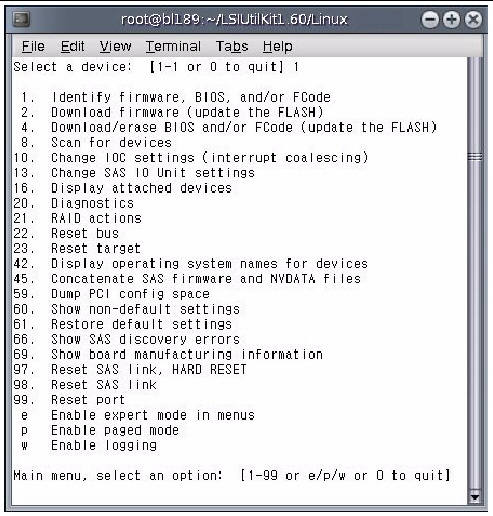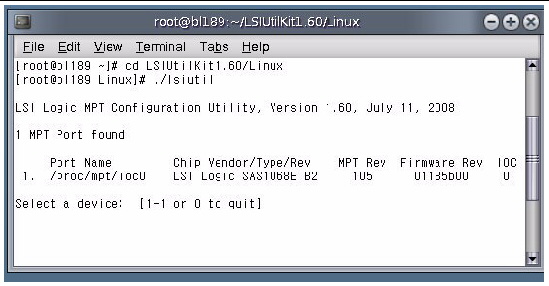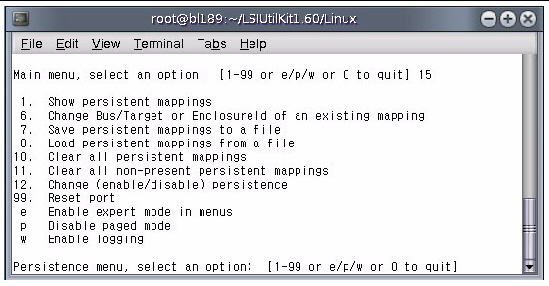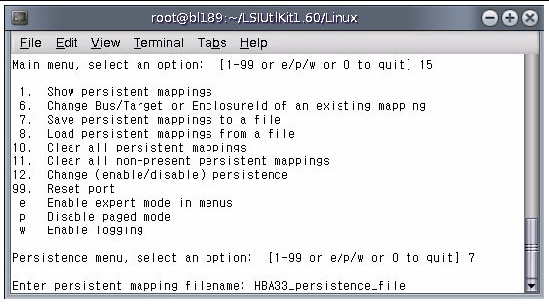| A P P E N D I X A |
|
Using the lsiutil Application |
The service procedure in this manual for replacing a Multi-Fabric NEM requires the use of a program called lsiutil. This appendix provides information on how to use the application.
The following topics are covered in this chapter:
To use lsiutil for the procedure in this appendix, you must have version 1.60 at minimum.
To obtain the latest lsiutil software, go to the disk blade download site:
http://www.sun.com/servers/blades/downloads.jsp#6000dm
Download lsiutil and unzip it in your root directory. It will create operating system-specific subdirectories. If you are running lsiutil on a SPARC blade, use the Solaris subdirectory. Otherwise, use the Solaris x86 subdirectory.
The procedure for clearing your LSI host bus adapter’s non-present persistence mappings requires using the interactive menus of lsiutil.
|
1. Log in to your server as root.
2. Change to the directory that contains the appropriate version of lsiutil for your OS. For example,
# cd directoryname/Solaris x86
3. If you have not done so already, change the permissions (read and execute access) on the lsiutil file by entering the following command:
4. Start lsiutil by entering the command:


You cannot see all the commands in the menu because they are too numerous, but you can enter any option number if you know what it is. In our case we want to open the Persistence menu. This is done with option 15.

7. Type 11 (Clear all non-present persistence mappings) and press Enter.
This clears any entries in the host bus adapter‘s persistence map that refer to target objects that are no longer present.

8. Type and enter 0 three times to exit the lsiutil application.
For various server configurations, you should save a “snapshot” file that contains the persistence mappings of your LSI host bus adapter. Then, in the event of a host bus adapter failure, you can restore the persistence mappings to a replacement adapter, allowing you to recover gracefully. See the Sun Blade 6000 Disk Module Service Manual (820-1703) for details.
1. Log in to your server as root.
2. Change to the directory that contains the appropriate version of lsiutil for your OS. For example,
# cd directoryname/Solaris x86
3. Enter the application name in the appropriate context. For example:


You cannot see all the commands in the menu, but you can enter any command number if you know what it is. In this case we want to open the Persistence menu. This is done with command 15.

6. Type 7 (Save Persistent Mappings to a File) and press Enter.
You are prompted for the name of the file where you want to store the host bus adapter configuration (persistent mappings).
7. Enter a file name. For example, HBA33_persistence_file.

The file is saved to the current directory. You get confirmation of this with a statement of the number of persistent entries saved.
8. Type and Enter 0 three times to exit the lsiutil application.

|
Caution - You mustsave the persistence table snapshot to external media as you will not be able to reinstall it from a local disk. |
Copyright © 2010, Oracle and/or its affiliates. All rights reserved.